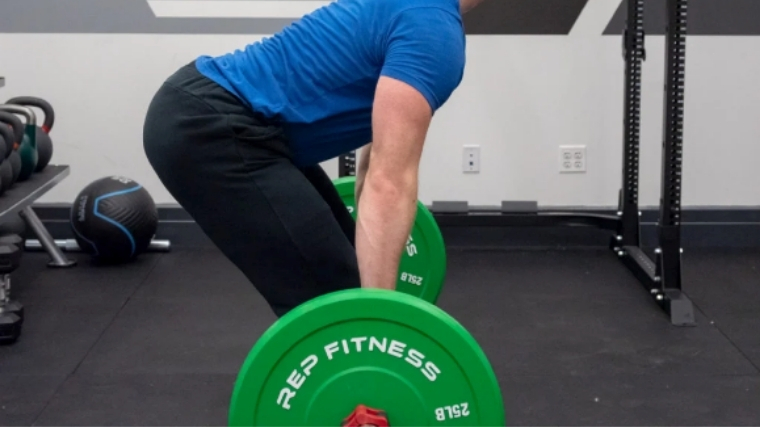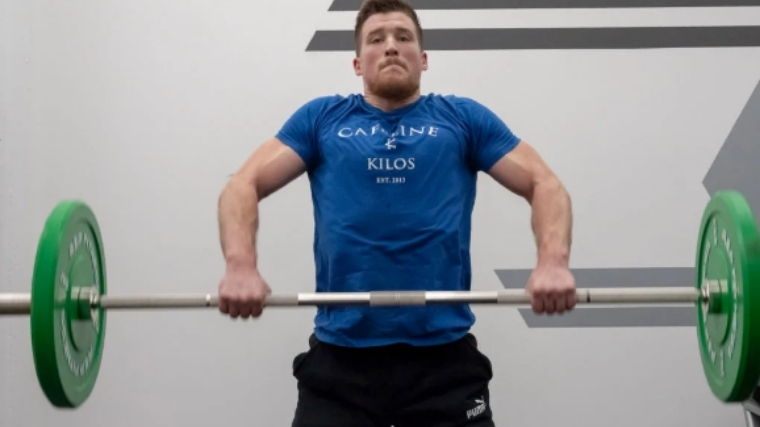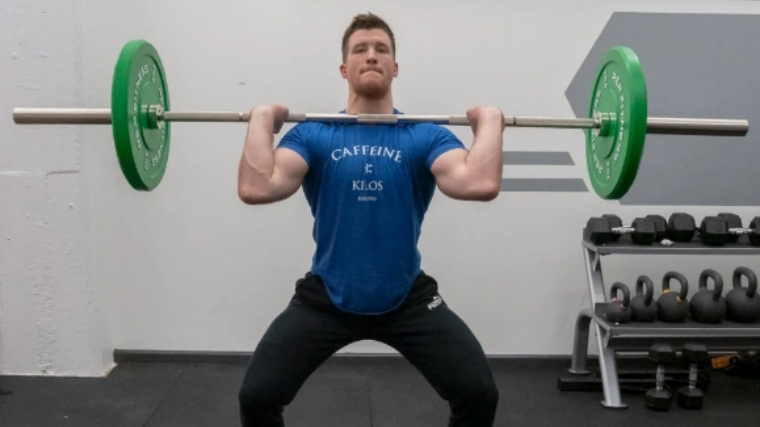Powerful hip drive is a must in strength sports. The ability to thrust with conviction leads to a stronger deadlift and squat, bigger glutes, and if you’re a weightlifter, more powerful and clean and jerks and snatches. Your hips are worked in every movement just mentioned, but you need to prioritize it to really master your hip drive. And few moves allow you to do this better than the hang clean.
Popular among weightlifters and CrossFit athletes, the hang clean has your drive a bar from knee level to shoulder height and then catch it in a front squat position. Sounds complicated? It isn’t really, and once you learn it, you’ll be rewarded with stronger lifts and more full-body power. Below, we’ll teach you how to do the hang clean, go over some popular alternatives, variations, and answer some frequently asked hang clean questions.
- How to Do the Hang Clean
- Benefits of the Hang Clean
- Muscles Worked By the Hang Clean
- Who Should Do the Hang Clean
- Hang Clean Sets, Reps, and Weight Recommendations
- Hang Clean Variations
- Hang Clean Alternatives
- Frequently Asked Questions
How to Do the Hang Clean
The below step-by-step guide discusses how to perform the barbell hang clean (receiving the bar in a full squat position).
Step 1 — Load the Hips
Stand tall with a barbell in your hands, arms extended down, and feet spread shoulder-width apart. With a slight bend in your knees, push your hips back until the bar is at knee height.
Form Tip: Ensure that the bar is close to your body.
Step 2 — Pull the Bar Upward
Push your feet into the floor and explosively pull the bar upward, keeping your chest up. Keep the bar close to your body and keep pulling until it’s in your hip crease.
Form Tip: Keep your chest up and over the bar.
Step 3 — Meet the Bar
Drive your hips forward as hard as you can so the bar comes forward. Then, begin to pull the bar up to your torso until it’s at your shoulders.
Form Tip: Pull the bar up toward you, with your elbows high, as if you’re doing an upright row.
Step 4 — Catch the Bar and Stand Up
As the bar ascends, drop into a deep squat and catch the bar in the front rack position. Your elbows should be up and facing forward. By the time you’re in the hole of your squat, the bar should be resting across your collarbone. Drive up until you’re standing.
Form Tip: Be sure to whip your elbows down and under the bar quickly.
Benefits of the Hang Clean
Below are three benefits of the hang clean and an explanation of why you should start to include hang cleans into your training program as a weightlifter, CrossFit athlete, fitness enthusiast, and sports athlete to improve your Olympic weightlifting.
More Power
The hang clean will help you increase muscular coordination and athleticism. Big-bodied explosive movements in nature often produce amazing results in power and force output, kinesthetic awareness, and neurological adaptations needed to train harder, run faster, and be a more explosive athlete.
Better Clean and Jerk Technique
The hang clean works to specifically increase a lifter’s ability to promote power and optimal of the barbell at the hip as he/she finishes their pull. Unlike the full clean, the hang forces a lifter to stay over the barbell and drive the legs into the floor while simultaneously focusing on the power development at the end of the movement. The lower the bar is to start, the more carryover you’ll have to a full clean and jerk, starting with the barbell on the floor.
Muscles Worked By the Hang Clean
The hang clean is a compound movement that primarily works the posterior chain and the legs, back, and core muscles. The below muscle groups are all active in the hang clean.

Hamstrings and Glutes
The hamstrings and glutes are engaged during the bar’s initial lowering phase, right before the first pull. During the hang clean, these muscles act like rubber bands, allowing tension to build before explosively thrusting the hips forward to initiate the lifting phase of the hang clean.
Quadriceps
The quads are worked during the catch and squat phase of the lift. They’re taxed isometrically as you sit in the hole of the squat with weight loaded in the front rack position. Then, they’re even more active as you squat up.
Back and Traps
Your entire back works hard to keep your torso upright during the squat portion of the exercise, as you’ll be inclined to dip forward during the front-loaded squat. Also, your traps will come into play mainly during the second pulling phase of the hang clean.
Who Should Do the Hang Clean?
The hang clean is a power-based movement that can help with athletic development and explosive strength. Below are a few lifting populations who can benefit from such a movement.
Strength and Power Athletes
Strength and power athletes can use the hang clean to improve overall athleticism, power production, and explosive strength. Additionally, Olympic weightlifters can use hang cleans to maximize clean and jerk performance.
- Powerlifters and Strongman/Strongwoman Athletes: More powerful hips and legs will allow you to move weight faster and breakthrough sticking points at the hip (think the lockout of your deadlift).
- Olympic Weightlifters: The hang clean is a variation to the clean and jerk, one of the two competition lifts. So, doing the hang clean will directly carry over to your performance on the platform.
Functional Fitness Athletes
Increased force and power output can lead to faster sprint times, longer/higher jumps, and more force production when hitting balls, throwing objects, and tackling opponents. Some CrossFit competitions/WODs include hang cleans, so they’ll directly impact your CrossFit performance, too.
Hang Clean Sets, Reps, and Weight Recommendations
Below are three primary programming recommendations depending on three separate goals.
To Improve Technique
For training technique and skill, start with three to five sets of three to five repetitions with 50 to 70 percent of your one-rep max. You should emphasize the positions, timing, and speed of the lift. This is not the time to let your ego get in the way of hang clean mastery.
To Increase Power Output
Perform four to six sets of two to three repetitions, with 65 to 80 percent of your 1RM. Be sure to perform these reps as powerfully and explosively as possible. Power begets power.
To Get Stronger
Strength requires very heavy weight performed for just a few reps. Do five to 10 sets of two to three repetitions, with 80 percent (or more) of your 1RM. Heavy hang cleans can be used to increase overall clean performance, pulling power and strength, and/or increasing the clean and jerk under heavier, near-maximal loads (which itself is a skill).
Hang Clean Variations
Below are three common hang clean variations that can be done to improve performance/skill, increase strength, and more.
Hang Power Clean
The hang power clean is done nearly identically to the hang clean, with the main difference being that the lifter doesn’t squat down to catch the bar. The hang power clean is an even more focused version of the hang clean, with this variation building purely hip drive.
No Foot Hang Clean
The no foot hang clean is done identically to the hang clean, except that the lifter does not lift or slide the feet after extension and while moving into the squat. The stance itself should be slightly wider at the start (squat stance) when compared to a regular hang clean. This variation forces vertical extension and balance in the pull.
Hang Clean Complex
The hang clean can be integrated into a wide variety of clean complexes, with movements like clean pulls, front squats, jerks, etc., all added into the movement. In doing so, you can increase training volume, address individual technical and strength limitations, and increase time efficiency within a training session.
Hang Clean Alternatives
Below are three hang clean alternatives that you can program to focus on different aspects of the lift or mix things up.
Block Clean
The block clean can help increase the rate of force development of the posterior chain, similar to the hang clean. However, it lacks the overall eccentric loading of the hips and hamstrings compared to the hand clean.
Hang Clean High Pull
The hang clean high pull is a hang clean alternative that omits the turning over of the barbell into the receiving squat position. Some coaches may choose this variation to limit wrist and shoulder stress (due to the front rack position) with some athletic populations. This is also a good alternative for lifters who may have injuries to the shoulders or wrists, yet are still looking to train.
Kettlebell Swing
The kettlebell swing is a ballistic movement that targets many of the same joint actions and muscle groups as the hang clean (however, it does not train the legs, back, or core as much due to not squatting the weight). This can be a good basic fitness exercise to introduce with lifters who may not have sufficient technique to train explosively with heavier loads.
FAQs
Yes. Many weightlifting coaches teach using a top-down method, with the hang clean being one of the first movements taught. The hang clean is a great way to simplify the pulling phase of a clean and jerk and help lifters learn how to properly extend upwards, finish the pull, then more underneath the barbell into the front squat. As they progress, new lifters can perform the hang clean from a lower-hanging position, until they move to the floor. This is also a great clean variation to increase the rate of force production for all levels as well. Not really. The hang clean is a power-based movement that needs to be done with speed and force. The best muscle-building exercises are typically done with a slower tempo and keep the target area engaged for the duration of the set. The hang clean engages the hamstrings, but only for a second or two. The same goes for the quads. If you want bigger thighs, you’re better off performing multiple sets and reps of front squats versus the one rep you do during each hang clean rep. For hamstring growth, stick with Romanian deadlifts or lying leg curls. If your goal is more power or sport-specific success, then the hang clean is your best bet. These are just starting points, but here are some goal-based set and rep suggestions. Can beginners do hang cleans?
Will hang cleans grow my muscles?
How many sets and reps should I do for the hang clean.
How do I do a hang clean?
Featured image: baranq/Shutterstock



